Hollow Venus and the Vensusian Cusps
Excerpts from Jan Lamprecht's Hollow
Planets, Chapter Six :
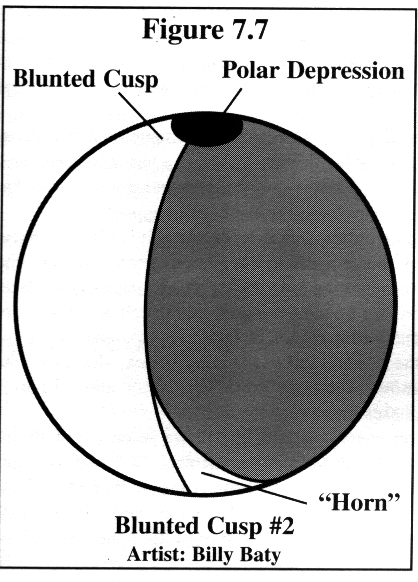 "Figure 7.7 shows a phenomenon which is probably extremely difficult
to detect. What if air is being sucked into Venus at one pole, while
it is being expelled at the other pole? In this case, we would have a
blunted cusp at one end and an extended horn at the other. It is
highly unlikely an astronomer would realise the existence of the
extended horn, since that end merely appears to end in a point, as
all crescents do. I have no doubt that such a situation has occurred,
but would be very difficult to detect. What this serves to
illustrate is the difficulty of detecting all occurrences of horns.
Horns are more easily detected at or near dichotomy when one can see
that the terminator is not straight. Horns and anomalous lighting of
Venus may be much more common than astronomers think. If there is
only one extended horn at a time it would be virtually impossible to detect."
"Figure 7.7 shows a phenomenon which is probably extremely difficult
to detect. What if air is being sucked into Venus at one pole, while
it is being expelled at the other pole? In this case, we would have a
blunted cusp at one end and an extended horn at the other. It is
highly unlikely an astronomer would realise the existence of the
extended horn, since that end merely appears to end in a point, as
all crescents do. I have no doubt that such a situation has occurred,
but would be very difficult to detect. What this serves to
illustrate is the difficulty of detecting all occurrences of horns.
Horns are more easily detected at or near dichotomy when one can see
that the terminator is not straight. Horns and anomalous lighting of
Venus may be much more common than astronomers think. If there is
only one extended horn at a time it would be virtually impossible to detect."
"In Figure 6.1
( below ) we can see a drawing of
the polar hoods or polar caps as seen by Trouvelot."
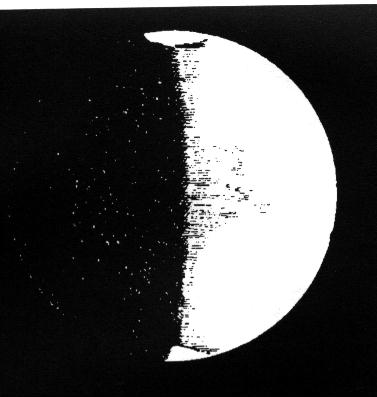
"Note how the terminator runs almost
straight down the middle of Venus except in the polar regions. Note too how the
bright polar caps are brighter than parts of the equator which receive more
direct sunlight. Look closely at the polar caps themselves and see how they
extend into the night side of Venus where the Sun can't possibly shine. This is
especially true of the one at the top of the drawing. There is a dark rim
around the bright area - this is the Venusian polar collar."
Our comments: The Venusian
angle and lighting, as depicted in Trouvelot's drawing above, would result
in two horns protruding onto the dark area which is not illuminated by the Sun.
This is depicted in Figure 7.4-
The effect can also be seen
in the images taken by Christophe Pellier on May 12, 2004, of the Association of
Lunar and Planetary Observers. ( He is not an advocate of the Hollow Earth/Planets
Theory ). By all means, consult his images for clarification, then come back for an
explanation (next to figure 7.4) by Jan Lamprecht: Christophe
Pellier
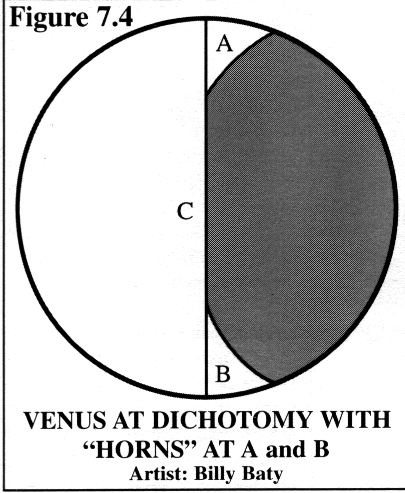 "But the Phase Anomaly can be solved simply, and decisively, when we realise that
the Venusian polar vortex is to blame. As Brinton and Moore noted themselves, one can have great
difficulty in determining the exact phase of Venus. Why? What if an Inner Sun were lighting up the Venusian polar regions? Based on all we have covered in these
chapters, let us now take a look at all the different combinations of lighting effects which can take place on Venus. By understanding these we should have no difficulty explaining the Phase Anomaly.
"But the Phase Anomaly can be solved simply, and decisively, when we realise that
the Venusian polar vortex is to blame. As Brinton and Moore noted themselves, one can have great
difficulty in determining the exact phase of Venus. Why? What if an Inner Sun were lighting up the Venusian polar regions? Based on all we have covered in these
chapters, let us now take a look at all the different combinations of lighting effects which can take place on Venus. By understanding these we should have no difficulty explaining the Phase Anomaly.
In Figure 7.4 we see
semi-circle C with the terminator as a straight line (regardless of whether Venus has a bulge or not). Note how the Horns, marked A and B protrude into the night side of Venus, into an
his would not be area which cannot possibly be lit by the Sun. This cannot be accounted for by refraction,
otherwise other areas along the terminator would exhibit the same effect."(
Jan Lamprecht)
Figure 7.9: (
below ) The Venusian Polar
Dipole
( Artist Billy Baty )
" When the Pioneer Venus Orbiter flew over the Venusian poles
it discovered long
elongated features stretching 4,000 Km across both poles. These features are in
the area where the Venusian Polar Holes should be."
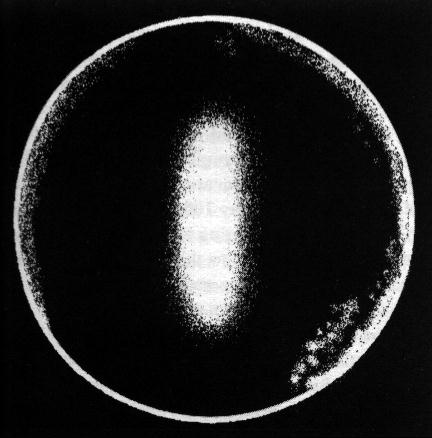
"In 1983, Tim Schofield and Diner reported in Nature:
'The Venusian polar dipoles are long-lived, elongated, warm features seen in images of thermal emission from the polar cloud tops of the planet. They are almost 4,000 km across,
are centred close to the pole, and appear to rotate with a period of
approximately 3 days retrograde'".
"The features were discovered by the Orbiter
Infrared Radiometer on board the
Pioneer Venus Orbiter. The features were only monitored for 72 days. They noted:
'Its rotation rate is observed to change steadily over the 72-day data set,
and there is some
evidence for oscillatory variations superimposed on this trend'".
"Oscillations? Air moving into and out of the planet perhaps? They found the
dipole to be an elongated warm (bright) structure when seen directly from above.
It extended down to 70°N and there were specific hot spots within it located
at 75°N. A cool (dark) polar collar surrounded it and extended to 60°N. They
found that although the dipole varied quite a bit from day to day, its 'gross
appearance and rotation rate is fairly stable'" (emphasis added).
"Schofield et al. did not know what caused the dipole."
Epic Moon-
" Most of Gruithuisen's observations were of the Moon, but he also paid
some attention to the planets. In December of 1813 he became the first to call
attention to the bright " polar spots " of Venus, which he thought might be snow
caps. In this he was mistaken, they are now known to be bright cloud swirls, but
at least he was right in assuming that they marked the positions of the planet's
poles."
Pages of Interest:
Smokestacks on The Moon
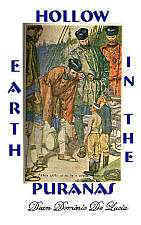
 "Figure 7.7 shows a phenomenon which is probably extremely difficult
to detect. What if air is being sucked into Venus at one pole, while
it is being expelled at the other pole? In this case, we would have a
blunted cusp at one end and an extended horn at the other. It is
highly unlikely an astronomer would realise the existence of the
extended horn, since that end merely appears to end in a point, as
all crescents do. I have no doubt that such a situation has occurred,
but would be very difficult to detect. What this serves to
illustrate is the difficulty of detecting all occurrences of horns.
Horns are more easily detected at or near dichotomy when one can see
that the terminator is not straight. Horns and anomalous lighting of
Venus may be much more common than astronomers think. If there is
only one extended horn at a time it would be virtually impossible to detect."
"Figure 7.7 shows a phenomenon which is probably extremely difficult
to detect. What if air is being sucked into Venus at one pole, while
it is being expelled at the other pole? In this case, we would have a
blunted cusp at one end and an extended horn at the other. It is
highly unlikely an astronomer would realise the existence of the
extended horn, since that end merely appears to end in a point, as
all crescents do. I have no doubt that such a situation has occurred,
but would be very difficult to detect. What this serves to
illustrate is the difficulty of detecting all occurrences of horns.
Horns are more easily detected at or near dichotomy when one can see
that the terminator is not straight. Horns and anomalous lighting of
Venus may be much more common than astronomers think. If there is
only one extended horn at a time it would be virtually impossible to detect."
 "
"
